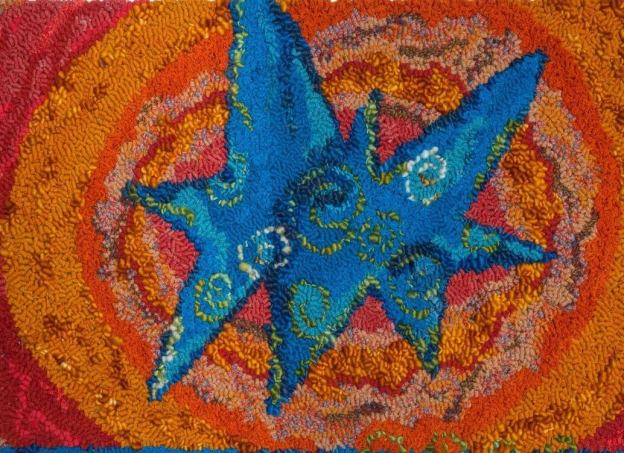I learned an artistic textile technique, rughooking, in 1994 and stepped into the pattern making (line drawings) by interpreting traditional folk motifs on frakturs. In other words using someone else’s visual design (centuries old and out of copyright infringement) and composing with an expected balance. I mastered skills, materials and tools and became proficient in the craft.

Adam and Eve, Susan L Feller 2000
By 1999 I wanted to grow into my own style and enrolled in a workshop “Balancing Act” lead by Rae Harrell at Green Mountain Rug Hooking Guild in Shelburne, VT. With an open mind and no planning lines were directly drawn on the foundation material, my colors selected from a comfort pile and friends contributions, and I began to hook breaking “rules” I did not even know I had adhered to when I saw others using different widths of strips in one piece! The result was Adam and Eve, completed in 2000 and juried by Mary Sheppard Burton into an exhibit Hooked Art in the 21st Century at the Textile Center, Minneapolis, MN.
I have continued this journey making patterns and more regularly creating artwork depicting the natural wonder around me in West Virginia, and communicating social and economic issues. All the while a panel hung in the studio labeled “work in progress-Adam and Eve weave”.

base, woven wool from Adam and Eve, Susan L Feller 2000-2016
I had pinned onto muslin strips of the fabrics used to hook Adam and Eve with intentions to stabilize them either subtly or with embroidery stitches and attach to the hooked piece creating a large pillow (22 x 24). A year of exploring past and new skills (Year Study), five years researching textile craftsmen from West Virginia (McDonalds), a source for discontinued upholstery samples and a conscious pull back to slow stitching with thrums from weaver Wendy Clark I finally felt it was the right time.
I enjoy composing, selecting materials and techniques each step interacting with the others until work can begin. There is a point of frustration when an idea can not be accomplished with existing materials or skills ….. the hunt for those takes away from the creative process but is essential if the work is going to be great instead of just good. I always have too many ingredients and need to simplify too.

upholstery samples, motifs from Design in a Box-Frakturs, Susan L Feller
-

-
Into the Garden, layout without blue motifs
-

-
Into the Garden, Eve with stitching
-

-
Into the Garden in progress Day 3
The two figures came out of my Design in a Box-Frakturs. Until the organic leaf with blue color upholstery was added, my design was ok but too equal in values, shapes and colors. I decided the figures did not need to have facial details for us to know who they were. By us looking at their backs and the plants layered over the bodies the title made sense. They are going into the garden where the serpent rises up on the hooked side.
-

-
embroidery needles
-

-
satin stitch on upholstery sample
-

-
embroidery work
The tools needed were simple: embroidery needle, threads, sharp scissors, and a few embroidery stitches from my past (satin, long and short, and back stitching) with my studio frame by Townsend Industries and Bob the supervising cat. By stretching the piece on a 14″ square frame I often used the left hand as precisely as my dominant right one. I involved people in the process using Instagram and Facebook postings (the images show my left hand holding tools often staged for the shot).
-

-
Bob on the frame with Susan
-

-
Back showing embroidery work
-

-
Susan working on final tacking stitches
Construction problems needed to be solved: selecting and installing a zipper (pillow form needs to be pulled out for transporting shell to workshops), anchoring edge with layers of wool and muslin and eliminating bulk for pillow, hand stitching two together when one was slightly larger than the other (measured but design grew, wool is a flexible material) but it all came together on January 16, 2017.

Into the Garden, Adam and Eve
-

-
Into the Garden
-

-
Adam and Eve, Susan L Feller 2000
The proverbial question asked of a craftsman “How long did it take you?” can be answered this time with “Seventeen years!”

































































































